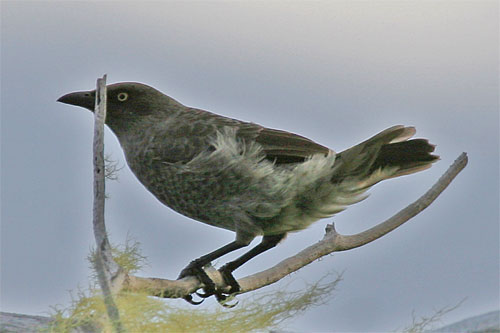(→Taxonomy: Update link) |
|||
| (4 intermediate revisions by 4 users not shown) | |||
| Line 1: | Line 1: | ||
| − | + | [[Image:RarotongaStarling3.jpg|thumb|550px|right|Photo by {{user|Marcus+Lawson|Marcus Lawson}}<br />Rarotonga, Cook Islands, August 2005]] | |
| − | + | ;[[:Category:Aplonis|Aplonis]] cinerascens | |
| − | [[Image:RarotongaStarling3.jpg|thumb|550px|right|Photo by Marcus Lawson | ||
==Identification== | ==Identification== | ||
| − | + | 21cm. A medium-sized starling. | |
| − | + | * Greyish-brown plumage | |
| + | * Lower belly and undertail-coverts whitish | ||
| + | * Pale yellow eye (sometimes dark brown with yellow outer ring) | ||
| + | * Dark lores creating a face mask | ||
| + | * Black bill and legs | ||
| + | Sexes similar. Juvenile undescribed.<br /> | ||
| + | Its voice is a whistling ''ee-oi, ee-oi'' call. | ||
==Distribution== | ==Distribution== | ||
| − | + | Endemic to Rarotonga Island in the southern [[Cook Islands]]. <br /> | |
| + | A restricted-range species, abundant 100 years ago but the population has declined to a few hundred birds, now confined to montane forests. Aggressive competition from the introduced [[Common Myna]] may be the reason for its disappearance from the lowlands. | ||
| + | ==Taxonomy== | ||
| + | This is a [[Dictionary_M-O#M|monotypic]] species. | ||
| − | |||
==Habitat== | ==Habitat== | ||
| − | + | Undisturbed montane forest, usually above 150m up to 600m (highest point of the island). Formerly also in the lowlands and at the coast. | |
==Behaviour== | ==Behaviour== | ||
| − | + | Feeds on fruit and insects, takes also nectar. <br /> | |
| − | The | + | Forages usually singly or in pairs.<br /> |
| + | Breeding season from August to December. The nest is placed in a tree hole with a clear preference for native trees. Lays 2 eggs.<br /> | ||
| + | A resident species. | ||
| + | ==References== | ||
| + | #{{Ref-Clements6thDec09}}#{{Ref-HBWVol14}} | ||
| + | {{ref}} | ||
==External Links== | ==External Links== | ||
{{GSearch|Aplonis+cinerascens}} | {{GSearch|Aplonis+cinerascens}} | ||
| − | [[Category:Birds]] | + | [[Category:Birds]] [[Category:Aplonis]] |
Latest revision as of 21:05, 11 July 2014
- Aplonis cinerascens
Identification
21cm. A medium-sized starling.
- Greyish-brown plumage
- Lower belly and undertail-coverts whitish
- Pale yellow eye (sometimes dark brown with yellow outer ring)
- Dark lores creating a face mask
- Black bill and legs
Sexes similar. Juvenile undescribed.
Its voice is a whistling ee-oi, ee-oi call.
Distribution
Endemic to Rarotonga Island in the southern Cook Islands.
A restricted-range species, abundant 100 years ago but the population has declined to a few hundred birds, now confined to montane forests. Aggressive competition from the introduced Common Myna may be the reason for its disappearance from the lowlands.
Taxonomy
This is a monotypic species.
Habitat
Undisturbed montane forest, usually above 150m up to 600m (highest point of the island). Formerly also in the lowlands and at the coast.
Behaviour
Feeds on fruit and insects, takes also nectar.
Forages usually singly or in pairs.
Breeding season from August to December. The nest is placed in a tree hole with a clear preference for native trees. Lays 2 eggs.
A resident species.
References
- Clements, JF. 2009. The Clements Checklist of Birds of the World. 6th ed., with updates to December 2009. Ithaca: Cornell Univ. Press. ISBN 978-0801445019.
- Del Hoyo, J, A Elliott, and D Christie, eds. 2009. Handbook of the Birds of the World. Volume 14: Bush-shrikes to Old World Sparrows. Barcelona: Lynx Edicions. ISBN 978-8496553507
Recommended Citation
- BirdForum Opus contributors. (2024) Rarotonga Starling. In: BirdForum, the forum for wild birds and birding. Retrieved 23 May 2024 from https://www.birdforum.net/opus/Rarotonga_Starling




